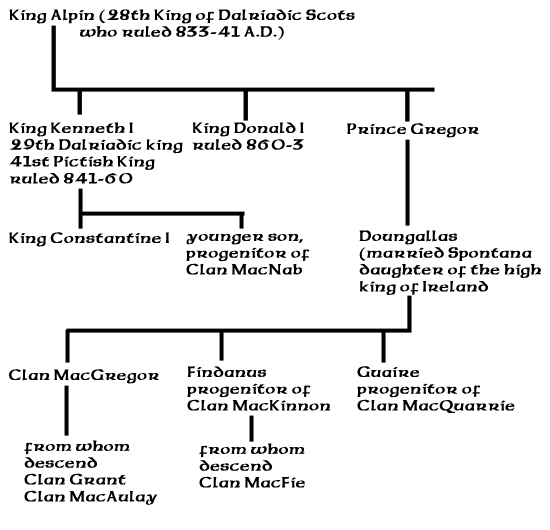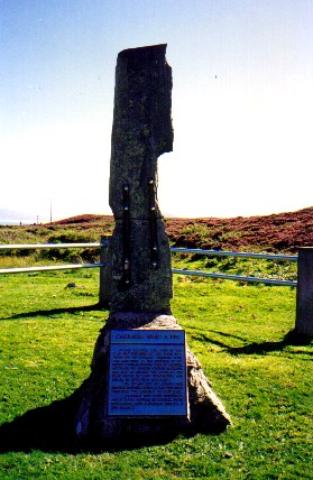According to http://www.seanet.com/~efunmoyiwa/ClanMacfie/, "The ancient name for [the Macfie] clan is Macdubhsith. While literally meaning 'dark man of peace', sithe is also the term used for supernatural beings that populated the islands and the highlands and the term dubh or dark also had mystical and supernatural connotations."
According to Micheil MacDonald's book "The Clans of Scotland", "The oldest form of the [MacFie/MacPhee/Duffie/MacDuffie] surname, recorded around 1240, is macdufthi -- close to the sound of the Gaelic MacDubhsithe, which could be translated as 'Son of the Secret Peacemaker' or even 'Son of the Fairy People'. It is one of the oldest surname constructions in the western world."
Note that the "Mac" prefix means "son of" in Gaelic, and "Mc" is just an abbreviation of "Mac".
Information copied from http://www.geocities.com/TelevisionCity/6145/Macfie.html:
Septs: (some of them) Athey, Cathie, Duffy, MacDuffie, McDuffie, MacAfee, Mahaffy, MacPhee, McPhee, McPhie, MacPhie, McFie, McGuffie, MacGuffie, McFee, MacFee.
Gaelic Names: Mac Dubh-shithe--Dark of Peace; Mac Dhuibh-Shith--Son of Dark Fairy
History: Early history of the Clan is unknown. It has been said that MacFie is "one of the oldest and most interesting personal names we possess". The MacFie's are said to be descended from a "Selkie" or seal woman, who cast off her fins to become a beautiful woman and she married the first MacFie who hid her fin, so that she could no longer return to the sea. The MacFie's are Celts, and are a branch of the great Siol Alpine. In Gaelic the clan name is Dubhsithe -- the dark featured tribe. Based on the carvings found on MacFie tombstones the Clan was made up of warriors and churchmen, the Clan was also Royalist. In 1549 the Isle of Colonsay, one of the Inner Hebrides, in Argyll, was recorded to be under the sway of "ane gentle Capitane called MacDuffyhe". His decendants would hold the Isle until the middle of the 17th century. In 1645 Coll MacDonald and his followers were charged with the murder of Malcom MacPhee of Colonsay, he would be the last chief of the MacFie's for many years. The MacPhees were dispossessed and merged into other more powerful clans, where they became conspicious for their courage. Many others settled on the shores of Ireland where they were called Macheffie or Macafee. Much later in history we find the reason behind the reputation MacFie's have for stealing sheep and other such lawlessness. In the mid-19th century, Ewan MacPhee (Eilean MhicPhee), of Loch Quoich, became 'famous' as the last of the Scottish outlaws. He recognised no law, and no landowner, and defended his homestead with firearms. It is Ewan MacPhee who was arrested for indulging in sheep stealing. On May 27th, 1981 the Clan MacFie was recognized and reactivated by the Lord Lyon and many of the Clan MacFie celebrate the anniversary of this day.
Siol Alpine (or Alpin; pronounced She-OAL AHL-pin, meaning the Seed of Alpin), mentioned in the above excerpt, is a clan whose history goes back to (King?) Alpin (a.k.a. Alpin II of Dalriada (?), or Alpin mac Eochaid (?)), whose successor Kenneth MacAlpin became, in 843 AD, the first king of Scotland to unite the Scots and the Picts. See http://en.wikipedia.org/wiki/Kenneth_I_of_Scotland and http://www.tartans.com/modules.php.srl.op+modload,name+News,file+article,sid+235,mode+thread,order+0,thold+0.html
I found the following genealogical diagram at http://www.clangrant-us.org/siol-alpin.htm, indicating that the Macfie clan descended from this line:

Information copied from http://freepages.genealogy.rootsweb.com/~bbunce77/Misc_Mahaffeys.html:
"The Gaelic name MacPhie gives the English phonetic spelling Macafie, sometimes shortened to Macfie or MacPhee. However, in its original form, the name was probably Mac Dhuibh Shith or 'Son of the Dark Fairy. . . . "
"The origin of the MacDuffie name is interesting and has given rise to much speculation. In Gaelic dub-shide or dudh-sithe means 'the black peace,' so MacDuffie can be translated as 'son of the black peace.' It has been suggested that this may refer to the dark robes worn by monks, but as the Gaelic word sithe (pronounced 'shee') can also mean 'magical' or 'supernatural,' the MacDuffie name could equally well have to do with 'black magic.' The word has even found its way into English in 'banshee,' from the Gaelic bean-sithe, the female fairy whose wailing and shrieking foretold the approaching death of a member of a family. It is by no means beyond the bounds of possibility that the hereditary MacDuffie priors of Oronsay had their ancestral roots in the remote pre-Christian past, as hereditary priests in the Iron Age or earlier. But of course, this must remain a matter of speculation. -- Norman Newton, Colonsay and Oronsay, 1990"
"CLAN MACFIE is one of the oldest Scottish Clans with a history going back before records were kept. Traditionally, the Clan homeland was the Islands of Colonsay and Oronsay off the westcoast of Scotland. The ancient Clan name was Macdhubhsith, meaning 'dark men of peace,' which anglicised to MacDuffie or Macfie. This latter spelling being that recognised to-day by the Lyon Court in Edinburgh as the Clan name. The names MacDuffie and Macfie appear interchangeable in old records. In the middle ages the Clan provided MacDuffie Priors for the Priory on Oronsay, and the Macfie Chief was Keeper of The Records for the MacDonald Lords of the Isles. The Clan's fortunes went into decline when that Lordship fell in 1493. Malcolm, last Chief of Clan Macfie, was murdered on Colonsay in 1623 and the Clan dispossed of its lands and dispersed as a 'broken' Clan. Following the initiatives of the late Dr. Earle Douglas MacPhee of Vancouver, Canada, in the 1970's the Clan was reactivated and again formally recognised as an 'active' Clan on 27th May 1981. To-day the Clan has eight Clan Societies established and Clan members are to be found around the world."
the progenitor of Clan MacDuffie (or the modern Macfie) was DUB-SIDHE (Dark man of the fairy mound in Gaelic)
Information copied from http://www.clanmacfiehomepage.org/:
In 1623, Malcolm, the last Chief of the Clan Macfie, was captured by the infamous Colla Ciotach MacDonald. He was tied to a Standing Stone, known as Carraig Mhic a' Phi at Balaruminmore, on our ancestral island of Colonsay, and summarily shot. The Clan Macfie was dispossessed of its lands and dispersed as a "broken" Clan.
That is, until 27th May 1981, when the Clan was reactivated and again formally recognised as an 'active' Clan by the Lord Lyon. Macfies all over the world celebrate that date as Clan Macfie Day - new 'birthday' for the Clan Macfie. As no hereditary Chief has been traced, a Ceann-Cath, or Clan Commander, was appointed to head the Clan. The current Clan Commander is Alexander (Sandy) C. McPhie who resides in Townsville, Queensland, Australia.
The Macfie Standing Stone on Colonsay:

The following names are recognised by the Commander of Clan Macfie, Ceann-Cath A. C. (Sandy) McPhie, as being current acceptable surname spellings for members of the Clan. Variations in the spelling of these names are acceptable. Mac/Mc prefixes are considered to be interchangeable.
ATHEY, ATHIE, CATHEY, CATHIE, COFFEE, COFFEY, DUFFEE, DUFFIE, DUFFEY, DUFFY, FEE, GUFFEY, GUFFIE, HAFFEY, HAFFIE, MacAFEE, MacAFIE, MacCAFFER, MacCAFFREY, MacCAFFIE, MacCATHEY, MacCATHIE, MacCUISH, MacDUFFEE, MacDUFFIE, MacDUFFEY, MacDUFFY, MacDUFFIN, MacFEE, MacFIE, MacGUFFEY, MacGUFFIE, MacGUFFIN, MacHAFFIE, MacHAFFY, MacPHEE, MacPHIE, MacVEE, MacVIE, MAHAFFEY, MEHAFFEY, PHEE, PHIE.
Yet another website: http://www.macfiesocietyofamerica.com/